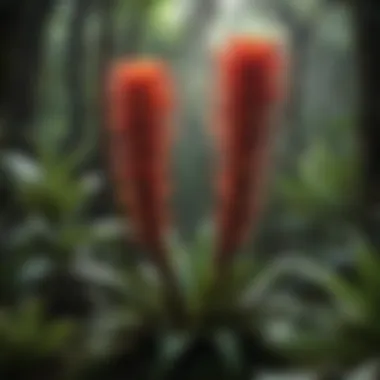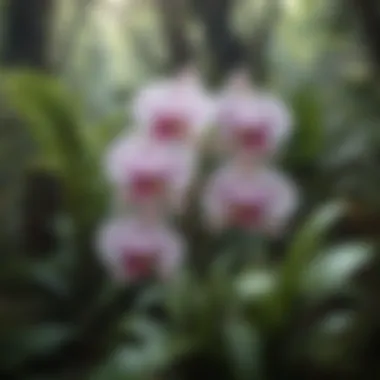Unveiling the Botanical Wonders of the Lush Tropical Rainforest


Nature Topic Overview
The tropical rainforest, a dense and vibrant ecosystem teeming with plant life 🌿, stands as a testament to the beauty and complexity of nature. From the towering canopy formed by majestic trees to the intricate network of undergrowth, this paradise of biodiversity captivates all who venture into its depths.
Fun Facts and Trivia
Discoveries await the curious minds exploring the tropical rainforest – did you know that some plants thrive high above the forest floor, nestled as epiphytes on tree branches? These fascinating flora receive nutrients from the air and rain, showcasing nature's ingenious adaptations. Delve into the world of botany with interactive elements and captivating visuals revealing the wonders of this enchanting ecosystem.
Wildlife Explorations
While plants take center stage, numerous animal species call the tropical rainforest home. From colorful birds like the resplendent quetzal to elusive mammals such as the jaguar, the flora and fauna of this habitat share intricate relationships that define their survival. Dive into quizzes and puzzling facts to unravel the mysteries of the rainforest's inhabitants.
Environmental Awareness
The preservation of the tropical rainforest is crucial for global biodiversity and climate regulation. Children hold the key to a sustainable future by understanding the significance of conservation. Discover practical tips on how each individual can contribute to safeguarding this vital ecosystem and promoting environmental stewardship.
DIY Nature Activities
Inspire budding naturalists with hands-on activities tailored to ignite their love for the outdoors. Engage in nature-inspired crafts or embark on guided explorations, fostering a deeper connection with the tropical rainforest's wonders. Step-by-step guides offer a gateway to creativity and environmental education for young learners.
Introduction
Embark on a fascinating journey into the heart of the tropical rainforest, a sanctuary of unparalleled biodiversity 🌿 This article immerses you in the world of exotic plant life, showcasing the intricate web of flora that thrives in this lush ecosystem. From towering trees to delicate ferns, each plant plays a crucial role in maintaining the fragile balance of this unique environment. Let's delve deep into the wonders of the tropical rainforest and unlock the secrets hidden within its verdant foliage.
Defining the Tropical Rainforest
The Tropical Rainforest stands as a bastion of biodiversity, characterized by its dense vegetation, high rainfall, and soaring canopy. This ecosystem boasts unparalleled species richness, with a myriad of plants coexisting in symbiotic harmony. The sheer expanse of the rainforest nurtures an environment teeming with life, each species contributing to the ecosystem's resilience and vitality.
Characteristics of the Tropical Rainforest
At the core of the Tropical Rainforest lie its defining characteristics – abundant rainfall, year-round warmth, and a complex stratification of vegetation. These elements create a habitat rich in resources and opportunities for plant growth, resulting in the incredible diversity that defines this biome. The ability of plants to thrive in this environment showcases nature's adaptability at its finest, as each organism has evolved unique strategies to capture sunlight, absorb nutrients, and survive amidst fierce competition.


Importance of Rainforests
The significance of rainforests transcends their sheer beauty; they serve as the lungs of the Earth, producing oxygen, regulating climate, and harboring countless species crucial to our planet's health. Rainforests act as a global reservoir of genetic diversity, offering potential solutions to medical, agricultural, and environmental challenges. Preserving these biodiverse ecosystems is not just a conservation imperative but a necessity for the well-being of present and future generations.
Overview of Plant Life
Dive into the kaleidoscopic world of tropical flora, where every leaf, flower, and vine plays a vital role in the intricate tapestry of life. The stunning array of plant species in the rainforest captivates the imagination, showcasing nature's creativity and resilience in the face of adversity.
Diversity of Flora
The diversity of plant life in the tropical rainforest is a testament to nature's boundless creativity. From towering trees that form the forest canopy to tiny understory plants seeking their niche in the dimly lit undergrowth, each species contributes to the mosaic of life that defines this ecosystem. The adaptation of plants to various niches within the rainforest highlights the intricate web of relationships that sustains this vibrant community.
Adaptations to the Rainforest Environment
Surviving in the competitive realm of the rainforest requires ingenious adaptations that set each plant apart. From epiphytic orchids that cling to tree branches to carnivorous pitcher plants luring prey into their depths, the strategies plants employ in this ecosystem are as diverse as they are fascinating. These adaptations reflect millions of years of evolution, fine-tuning each plant to thrive in its unique microhabitat.
Layers of Vegetation
In the incredible realm of the tropical rainforest, the Layers of Vegetation stand as a fundamental aspect deserving our attention. These layers – from the emergent layer to the forest floor – play a crucial role in the ecosystem's balance and functionality. Understanding the unique characteristics and interactions within each layer is key to appreciating the complexity of plant life in this vibrant environment.
Emergent Layer
Characteristics of the Emergent Layer
The Emergent Layer, situated at the very top of the rainforest canopy, showcases remarkable features that set it apart. With towering trees reaching great heights, this layer captures the spotlight for its ability to withstand strong winds and intense sunlight. These emergent giants serve as anchors for vines and epiphytes, displaying a robust structure that symbolizes resilience in challenging conditions. Their sheer size not only contributes to the rainforest's rich biodiversity but also provides a habitat for various creatures seeking refuge high above the forest floor.
Plant Species Found
Within the Emergent Layer, a diverse array of plant species thrives, each uniquely adapted to its elevated environment. From towering Kapok trees to majestic Mahogany species, the flora in this layer showcases a blend of strength and adaptability. The wide canopies of these trees provide shade and protection for the layers beneath, creating a microclimate that supports a multitude of life forms. The presence of rare orchids and bromeliads further enhances the beauty and richness of this uppermost layer, drawing admiration for their tenacity and striking blooms.
Canopy Layer
Significance of the Canopy Layer
The Canopy Layer, nestled beneath the Emergent Layer, plays a vital role in the tropical rainforest ecosystem. Its dense network of leafy crowns forms a green umbrella that shields the layers below from excessive sunlight and regulates the microclimate. This layer acts as a hub of activity, harboring diverse plant species, insects, birds, and mammals that rely on its abundance for food and shelter. The rich biodiversity found in the canopy underscores its critical importance in maintaining the delicate balance of the rainforest ecosystem.
Epiphytes and Bromeliads
One of the iconic features of the Canopy Layer is the proliferation of epiphytes and bromeliads, which adorn tree branches with their unique growth habits. These plants, known for their ability to grow without soil, have evolved intricate methods to capture water and nutrients from the air. Epiphytes like orchids and ferns create stunning displays of color, while bromeliads form rosettes that collect rainwater, providing a vital resource for canopy-dwelling organisms. Their symbiotic relationships with other flora and fauna highlight the interconnectedness of life within this verdant layer.
Understory Layer
Plant Adaptations to Low Light
The Understory Layer, shrouded in the shadows cast by the upper canopy, hosts plants that have adapted to limited light conditions. Here, species like ferns and understory palms thrive by maximizing their photosynthetic efficiency and spreading their leaves to catch filtered sunlight. These plants showcase a diverse range of strategies to survive in the shade, demonstrating resilience and innovation in challenging environments. The understory's unique floral composition adds depth to the rainforest's biodiversity, enriching the ecosystem with its specialized plant species.
Herbaceous Plants
Complementing the taller vegetation above, the Understory Layer is home to a myriad of herbaceous plants that carpet the forest floor with lush greenery. These low-growing plants, including ground ferns and wild gingers, play essential roles in nutrient cycling and soil stability. Their delicate forms and intricate foliage provide habitats for insects and small animals, creating a bustling microcosm within the understory. Despite the dense competition for light and resources, herbaceous plants persist and thrive, contributing to the overall resilience of the rainforest ecosystem.
Forest Floor
Decomposers and Detritivores
Beneath the layers of vegetation lies the Forest Floor, where decomposers and detritivores carry out crucial roles in nutrient recycling. Fungi, bacteria, and insects break down organic matter, releasing essential nutrients back into the soil for plant uptake. This process of decomposition is vital for sustaining the rainforest's productivity and supporting the growth of new vegetation. The forest floor teems with life in various stages of decay, showcasing the intricate web of interactions that govern nutrient cycling and energy flow in this dynamic ecosystem.
Shade-Tolerant Plants
Thriving in the dimly lit understory, shade-tolerant plants have evolved specialized adaptations to make the most of low light levels. Plants like peace lilies and calatheas possess broad leaves designed to capture every available photon, ensuring efficient photosynthesis even in the shadowy depths of the rainforest. Their ability to flourish under challenging light conditions highlights the ingenuity of nature's design, showcasing the resilience and diversity of plant life in every corner of the tropical rainforest.
Key Plant Species
In this section, we will delve into the significance of key plant species within the tropical rainforest ecosystem. These plant species play a crucial role in maintaining the biodiversity and ecological balance of this intricate environment. By exploring their unique characteristics and adaptations, we gain valuable insights into the complexity and resilience of tropical rainforest flora. Understanding the key plant species enriches our appreciation for the botanical diversity that thrives in this lush habitat.


Amazonian Giant Water Lily
The Amazonian Giant Water Lily stands out for its extraordinary features that distinguish it within the tropical rainforest. Its massive leaves, capable of supporting the weight of a small child, make it an icon of the waterways in the rainforest. This unique structural adaptation allows the lily to thrive in the canopy openings where sunlight penetrates, maximizing its photosynthetic capabilities. The waxy texture of its leaves prevents water from penetrating, keeping them afloat and creating a spectacle of natural beauty. The Amazonian Giant Water Lily's role in the ecosystem extends beyond its visual appeal. Providing shade and shelter for aquatic creatures, it creates microhabitats that support diverse forms of life within the rainforest waters.
Strangler Figs
The life cycle and growth habit of the Strangler Fig plant are intriguing facets of its existence in the tropical rainforest. Beginning as an epiphyte high in the canopy, the Strangler Fig sends roots downward, eventually enveloping the host tree and competing for sunlight. This unique growth strategy allows the fig to access vital nutrients and establish a stronghold in the rainforest ecosystem. The ecological importance of Strangler Figs lies in their role as keystone species, providing food and shelter for numerous animals. Their ability to colonize both living and decaying trees underscores their adaptability and resilience within the competitive rainforest environment.
Pitcher Plants
Carnivorous adaptations set Pitcher Plants apart in the botanical realm of the tropical rainforest. Their specialized leaves form intricate pitchers, containing digestive fluids that break down captured prey. This carnivorous strategy enables Pitcher Plants to supplement their nutrient intake in the nutrient-poor soils of the rainforest. The ecological significance of Pitcher Plants lies in their contribution to nutrient cycling, as they consume insects and small organisms, closing the loop of energy flow and resource utilization within the ecosystem. Their unique method of nutrient acquisition showcases the diversity of plant strategies in the rainforest, highlighting the fascinating evolutionary pathways that have led to their survival and proliferation.
Bromeliads
Water-holding structures are the defining feature of Bromeliads, allowing them to thrive in the moisture-laden environment of the tropical rainforest. These structures, known as 'tanks,' collect rainwater and form miniature ecosystems, harboring a variety of specialized organisms. Bromeliads engage in symbiotic relationships with various creatures like tree frogs and insects, creating intricate webs of interdependence within the forest ecosystem. Their adaptability to diverse conditions, from forest floors to canopy perches, showcases their versatility and resilience in the face of environmental challenges. By examining Bromeliads' unique features and symbiotic associations, we gain a deeper understanding of the intricate web of life that characterizes the tropical rainforest.
Threats to Rainforest Plant Life
In our exploration of the plant life in the tropical rainforest, it is crucial to address the significant threats that jeopardize the delicate balance of this rich ecosystem. Understanding these threats is vital for creating awareness and promoting conservation efforts to safeguard the biodiversity of the rainforest. By delving into the specific factors that pose risks to rainforest plant life, we can gain insight into the challenges faced by these vital ecosystems.
Deforestation
Impact on Biodiversity
The impact of deforestation on biodiversity within the tropical rainforest is profound. Deforestation, primarily driven by human activities such as logging and agricultural expansion, leads to the loss of crucial habitats for countless plant species. This destruction of natural habitats results in the displacement and potential extinction of numerous plant species, disrupting the intricate web of interdependence within the ecosystem. The decline in plant biodiversity not only diminishes the aesthetic beauty of the rainforest but also hampers its overall ecological resilience and functionality.
Conservation Efforts
Addressing the pressing issue of deforestation requires concerted conservation efforts aimed at preserving the invaluable plant life of the rainforest. Conservation initiatives encompass measures such as establishing protected areas, implementing sustainable land use practices, and promoting reforestation initiatives. Conservation efforts also involve working collaboratively with local communities and indigenous tribes to achieve mutually beneficial conservation goals. By fostering a sense of stewardship and responsibility towards the rainforest, conservation efforts play a pivotal role in mitigating the adverse effects of deforestation and safeguarding the diverse plant species that call the rainforest home.
Climate Change
Effects on Plant Adaptations
The exacerbation of climate change poses significant challenges to the unique adaptations of plant species in the tropical rainforest. Shifts in temperature patterns, altered precipitation levels, and changing weather dynamics disrupt the finely tuned adaptations of rainforest plants. These changes impact crucial processes such as seed germination, flowering cycles, and symbiotic relationships with pollinators or seed dispersers. The intricate balance between plant species and their surrounding environment becomes increasingly vulnerable in the face of escalating climate change, necessitating adaptive responses to ensure the resilience of rainforest plant life.
Mitigation Strategies
Mitigating the adverse effects of climate change on rainforest plant life necessitates the implementation of proactive strategies to enhance the adaptive capacity of plant species. Mitigation efforts may encompass initiatives focused on habitat restoration, enhancing genetic diversity within plant populations, and monitoring the impacts of climate change on key plant species. Collaborative research endeavors and knowledge sharing platforms play a crucial role in identifying resilient plant species and developing targeted mitigation strategies to mitigate the effects of climate change on tropical rainforest plant communities.







